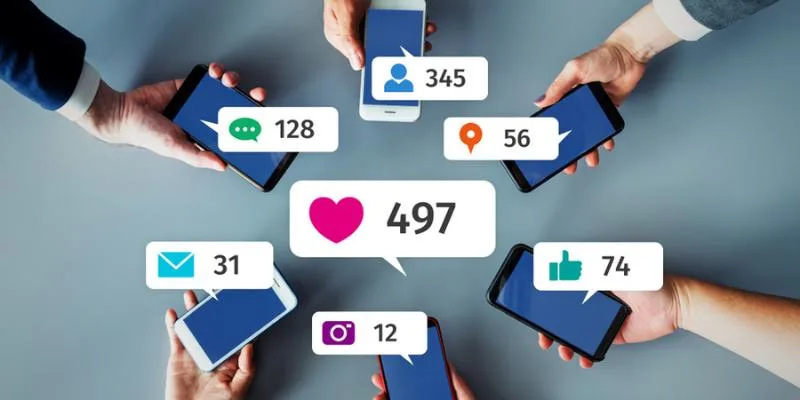LinkedIn is often known as a Professional Networking Platform, and it is currently the most business-focused Social Media Platform. Although you may connect with friends and family, LinkedIn isn’t used in the same way as Facebook or Instagram are. You will likely use LinkedIn to connect with people that you have worked with or like-minded individuals in your industry.
Similar to Facebook, LinkedIn has a Business Page feature which you can use to share business updates and gain followers. Follow these nine initial steps to setting up your LinkedIn Business Page.
Setting up your LinkedIn Business Page
Start by logging in to your personal LinkedIn account. You will be able to create a page from here and automatically be ‘admin’. If necessary, you can add other LinkedIn users as admin so they can post as your business page.

In the top right of your screen, you should see a ‘Work’ tab under a cube icon made up of nine squares. Click here and then ‘Create a Company Page’.
You will now be prompted to select the business-size most suited to you*:
*for this post, we’ll be selecting small business.

Next, start populating the page with all the critical information about your business. You’ll see that there are some required details and some optional. First, choose your LinkedIn Business Page Name (up to 100 characters). This should be your Busines Name. You can then create your public URL, which will be linkedin.com/company/ *insert name*.

Adding your website is optional, but the more information you include in your business page, the better. It should be as easy as possible for your customers to find you, understand who you are and what you do, and then engage.
You will be required to populate your Industry, Company Size and Company Type. LinkedIn makes this super easy by giving you dropdown fields to choose from.
The last section to complete at this point is your logo and tagline. Upload your logo as 300×300 pixels in JPG, JPEG or PNG format. You have just 120 characters for your LinkedIn tagline, so make sure it’s short and sweet but summarises your business. Your tagline can be changed at a later date.
To give you an idea of what your page is going to look like, there is a preview along the right of the screen that will be populated with the information that you’re inputting as you go.
Finally, tick the box to verify that you have the authority to create a page on behalf of this business and hit the ‘Create Page’ button!
Hero Image
Despite the fact you’ve created your LinkedIn business page, there are still some sections yet to be updated. For example, you can upload a hero image (1128×376 pixels) which appears at the top of the page behind your profile picture. A hero image helps bring another visual aspect to the page and is a chance to showcase more information around your products or services.

About Your Business
You are also able to add additional information about your business. Do this by clicking ‘Edit Page’. Here you can populate:
- Description – (up to 2000 characters)
- Phone Number
- Year Founded
- Specialities (up to 20)
Buttons
There are two buttons on your business page, the first is ‘Follow’ encouraging your audience to follow the page and the second can be customised by you, based on what’s the most relevant call to action for your business, with a URL behind it. The options are:
- Contact us
- Learn more
- Register
- Sign up
- Visit website
Locations
Here you can add the location of your business, this could be your head office or shop, for instance. If your business AOI covers several locations, then add all of these so your customers can visit the one closest to them. If your business doesn’t have a street address, then you can exclude this section from your page.
Hashtags
As with the majority of Social Media Platforms now, LinkedIn utilises the #hashtag functionality to link content with other users. You can add up to three relevant hashtags to your business page and then see and respond to trending posts from the ‘hashtag feed’. The hashtag feed will help you stay in the loop with what’s most relevant to you, as well as hopefully increase the reach of your organic posts when you include the hashtags.
LinkedIn Groups
If you are a member of specific LinkedIn Groups, you can add these to your page as ‘Featured Groups’. This means that members can see and request to join the groups from your page.
Languages
Where relevant, you can add other languages for the page name and description, this will help if you’re international. However, if this is the case, you may wish to create a LinkedIn Business Page per country, so your posts are in the correct language for your audiences.
Growing Your Followers
Now that you’ve completed your LinkedIn Business Page, it’s time to grow your following. The easiest place to start is to encourage your employees to follow the page. Not only will this help build up a few initial followers, but they will also be able to stay up to date with the business news.
Another way to grow your following is to invite your connections to follow the page. If you are going to choose this option it’s worth only inviting the most relevant of relationships, otherwise, you risk wasting your reach on people who follow you because you asked them to, not people who actually want or need to see your updates.
For more great tips on managing your LinkedIn profile and LinkedIn business page visit our blog “The Ultimate Guide to LinkedIn.”


